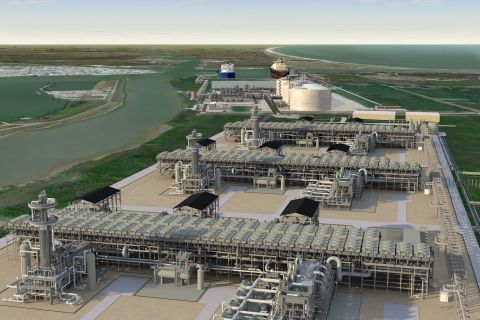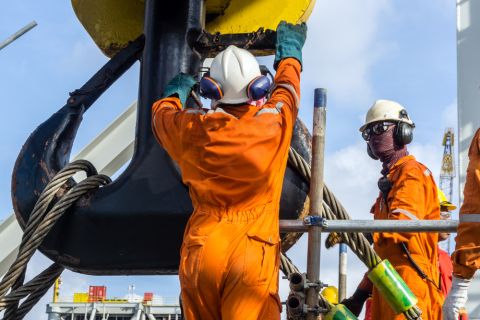
Don Raikes, senior vice president of Dominion Midstream Operations’ gas infrastructure group, speaks to attendees at the recent Marcellus-Utica Midstream Conference. Source: Hart Energy
PITTSBURGH—Projects like Cove Point LNG have been on the horizon for so long that Don Raikes’ simple declaration at the recent Marcellus-Utica Midstream Conference drew a few gasps.
“Our projected in-service date is early March 2018, very soon,” said Raikes, senior vice president for Dominion Midstream Operations’ gas infrastructure group. “We made our first LNG two days ago.”
The conversion of Dominion’s (NYSE: D) 1,000-acre facility from import facility to major bi-directional terminal was not just going to happen but was happening.
“Cove Point is a game-changer, both in terms of Northeast market and world LNG,” Raikes said.
At least part of the reason is that its Maryland home on the Eastern Seaboard positions Cove Point near the mighty Marcellus Shale. It’s a point that is not lost on potential customers.
“When I toured the world selling Cove Point capacity with my team, the one word that you didn’t need an interpreter for—wherever you were—is Marcellus,” Raikes said. Subscribers include representatives from LNG-thirsty countries such as ST Cove Point, a joint-venture of Sumitomo Corp. and Tokyo Gas Co. Ltd.; and the U.S. affiliate of GAIL (India) Ltd.
While access to natural gas from the Marcellus and Utica is a key selling point, along with the Cove Point’s stature as only the second U.S. LNG export facility to begin operation (after Cheniere Energy Inc.’s Sabine Pass, La.) and first on the East Coast, Raikes also emphasized the tolling business model.
“Our model allows our customers the flexibility to go out and acquire the supplies that they want, negotiate the terms on the supplies that they want, get the transportation,” he said. “They deliver to our plant, we convert it into LNG and put it in their ship.”
Advantages of this system include:
- The customer controls its own destiny with supply;
- Not only is there no supply risk for Cove Point, but the deal is take-or-pay; and
- Customers have no restrictions on commercial destinations: “They are free on the market within the regulations that they have,” Raikes said.
“The minute they sign these U.S. contracts, [our customers] have significant benefits in the renegotiation of the contracts they already have,” he said. “This gave them newfound flexibility even before the plant came online.”
Flexibility also extends to the size of the tanker. Cove Point has two berths that are able to handle Q-Max, or Qatar-Max tankers, the largest LNG carriers in the world.
Maritime Connector website describes the typical Q-Max as 1,132 feet long, 177 feet wide and 114 feet in height. The ships can carry up to 162 million cubic meters of natural gas, or enough to power 70,000 U.S. homes for a year. Onboard is a re-liquefaction unit to limit LNG losses during the voyage and keep toxins from leaking into the sea.
Sabine Pass can handle Q-Max vessels as well, but neither the Q-Max nor the smaller Q-Flex tankers can traverse the Panama Canal.
Cove Point was built in the 1970s as an import terminal and became dormant after just a few years. Dominion bought it in the early 2000s and began importing gas. In 2011, the company filed an export application, then began the paperwork process with the Federal Energy Regulatory Commission (FERC) in 2012. Final applications were submitted in 2013, followed by FERC approval and start of construction in 2014.
Only 130 of the 1,000 acres are occupied by the plant. The rest are devoted to conservation and Raikes appeared proud to mention the awards Dominion has received for its environmental stewardship.
He is also proud of the role Cove Point will play in the emerging U.S. LNG export sector. This year, 10% of the country’s natural gas production will be exported; by 2022, that share will be 18%.
“When you look at the world demand,” he said, “there is a significant amount of growth opportunity for LNG.”
Joseph Markman can be reached at jmarkman@hartenergy.com and @JHMarkman.
Recommended Reading
Segrist: The LNG Pause and a Big, Dumb Question
2024-04-25 - In trying to understand the White House’s decision to pause LNG export permits and wondering if it’s just a red herring, one big, dumb question must be asked.
Texas LNG Export Plant Signs Additional Offtake Deal With EQT
2024-04-23 - Glenfarne Group LLC's proposed Texas LNG export plant in Brownsville has signed an additional tolling agreement with EQT Corp. to provide natural gas liquefaction services of an additional 1.5 mtpa over 20 years.
US Refiners to Face Tighter Heavy Spreads this Summer TPH
2024-04-22 - Tudor, Pickering, Holt and Co. (TPH) expects fairly tight heavy crude discounts in the U.S. this summer and beyond owing to lower imports of Canadian, Mexican and Venezuelan crudes.
What's Affecting Oil Prices This Week? (April 22, 2024)
2024-04-22 - Stratas Advisors predict that despite geopolitical tensions, the oil supply will not be disrupted, even with the U.S. House of Representatives inserting sanctions on Iran’s oil exports.
Association: Monthly Texas Upstream Jobs Show Most Growth in Decade
2024-04-22 - Since the COVID-19 pandemic, the oil and gas industry has added 39,500 upstream jobs in Texas, with take home pay averaging $124,000 in 2023.





